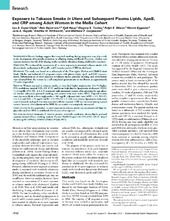Exposure to Tobacco Smoke in Utero and Subsequent Plasma Lipids, ApoB, and CRP among Adult Women in the MoBa Cohort
Cupul-Uicab, Lea A; Skjaerven, Rolv; Haug, Kjell; Travlos, GS; Wilson, RE; Eggesbø, Merete Åse; Hoppin, Jane A; Whitworth, KW; Longnecker, MP
Peer reviewed, Journal article
Published version

Åpne
Permanent lenke
https://hdl.handle.net/1956/12166Utgivelsesdato
2012-11Metadata
Vis full innførselSamlinger
Originalversjon
https://doi.org/10.1289/ehp.1104563Sammendrag
Background: Recent findings suggest that maternal smoking during pregnancy may play a role in the development of metabolic alterations in offspring during childhood. However, whether such exposure increases the risk of developing similar metabolic alterations during adulthood is uncertain. Objective: We evaluated the association of in utero exposure to maternal tobacco smoke with plasma lipids, apolipoprotein B (apoB), and C-reactive protein (CRP) in adulthood. Methods: The study was based on a subsample of the Norwegian Mother and Child Cohort Study (MoBa) and included 479 pregnant women with plasma lipids, apoB, and CRP measurements. Information on in utero exposure to tobacco smoke, personal smoking, and other factors were obtained from the women by a self-completed questionnaire at enrollment, at approximately 17 weeks of gestation. Results: Women exposed to tobacco smoke in utero had higher triglycerides [10.7% higher; 95% confidence interval (CI): 3.9, 17.9] and lower high-density lipoprotein cholesterol (HDL) (–1.9 mg/dL; 95% CI: –4.3, 0.5) compared with unexposed women, after adjusting for age, physical activity, education, personal smoking, and current body mass index (BMI). Exposed women were also more likely to have triglycerides ≥ 200 mg/dL [adjusted odds ratio (aOR) = 2.5; 95% CI: 1.3, 5.1] and HDL < 50 mg/dL (aOR = 2.3; 95% CI: 1.1, 5.0). Low-density lipoprotein cholesterol, total cholesterol, and apoB were not associated with the exposure. CRP was increased among exposed women; however, after adjustment for BMI, the association was completely attenuated. Conclusions: In this population, in utero exposure to tobacco smoke was associated with high triglycerides and low HDL in adulthood, 18–44 years after exposure.